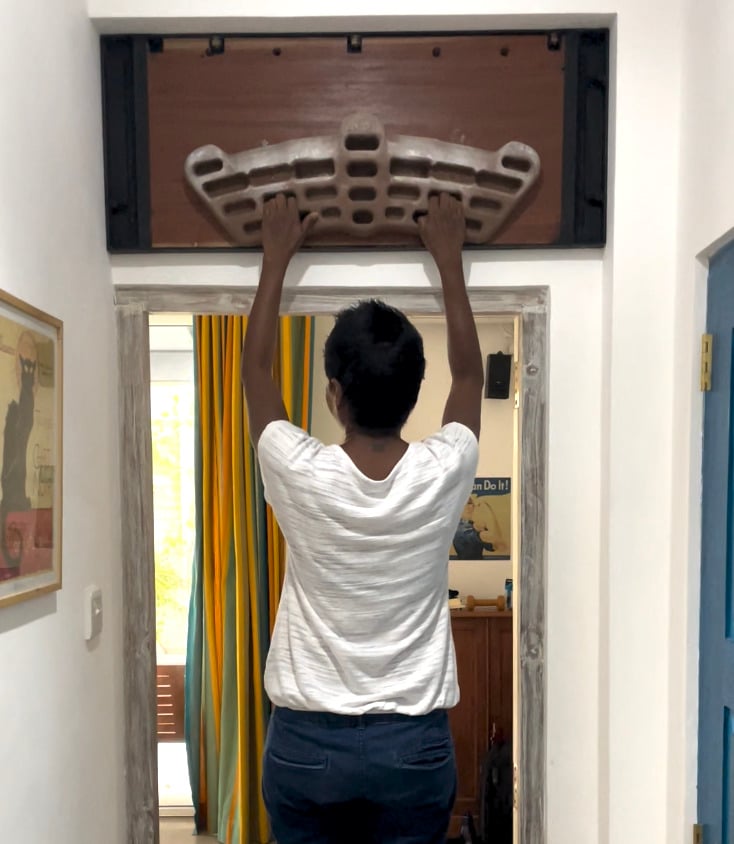
For International Mountain Day 2022, we speak to Jay, the first Sri Lankan to summit Mt. Everest, as she takes on a bigger, more challenging climb: the societal barriers women face.
For decades, people have dared to dream of summiting the alluring Mount Everest for reasons beyond what the average mind can fathom. The dangerous climb has claimed many lives and will, unfortunately, continue to be one of the most hazardous treks mankind will ever undertake. This is why Everest has been a persistent metaphor for overcoming impossible struggles in history.
Jayanthi Kuru-Utumpala (Jay) — a Sri Lankan mountaineer, rock climber, activist and feminist — is one of those dreamers who were lucky enough to make it to the top. Yet today, she continues to take on the mountainous challenge of breaking barriers for women and girls — including the ones she faces herself.
Taking on Everest
It was an unusually warm and noisy afternoon in the city when we showed up at Jay’s doorstep for the interview. Greeting us with a bright smile, Jay began flurrying around in the kitchen, trying to get us drinks and snacks — as is customary in Sri Lanka — as we politely protested with “No, no. It’s okay, really. We’re fine!”, as guests do.
Following this, we sat down with her at the table and it was an instantaneous and refreshing change of both pace and scenery from the outside world.
Dappled in light greens and warm brown tones and adorned with various potted plants, it felt like we’d walked through a magical wardrobe — except, instead of Narnia, it felt like a cool and cosy forest getaway. It was clear Jay was deeply in touch with nature, and the roots of her passion go all the way back to her childhood.
Many children dream of fantastical journeys. For example, I wanted to go to space — mainly because I knew the chances of me actually having to go were rather slim. But for Jay, this turned out to be a very real possibility.
“I decided to climb Mount Everest for a very simple reason —- this was something that I wanted to do since I was about eight years old. It was a childhood dream, and it was also something that I never imagined would be possible,” she said, with a look of deep nostalgia and fondness.
I asked what motivated her to take on Everest — an incredibly risky (and expensive) challenge, and her answer was a simple “I guess it was something that I really wanted — much more than a bucket list, and I’m really privileged that I was able to climb this mountain.”
As cool and calm as that answer sounds, Jay is not one to underplay the very real dangers that Everest posed. “The hardest part of climbing Everest for me was the fear of death on this mountain because dying on the mountain is quite a reality,” she said, highlighting how people lose their lives attempting the climb every year.
It’s a two-month journey riddled with inevitable complications, from unpredictable weather to sudden avalanches, altitude sickness, and more. “There are temperatures that drop down to -60°C close to the summit. We go through an area called the Dead Zone, which is a very apt name,” she smiled.

As it turns out, the preparation for the climb is complicated — in more ways than one.
Taking a moment to weigh what she was about to say next, Jay stated: “I wrote my last will before I went because the weather is something that you cannot predict sometimes. We did everything we could within our control to mitigate the risks, and we did whatever we could in terms of planning and preparation. The gear that we invested in and of which brands — all of this mattered.”
While her successful summit and safe return were lauded and many called her brave for it, Jay shared that this was the furthest thing from the truth. “I was really scared, all the way up and all the way down, but you do what you’ve gotta do, right?”
Indeed, but what awaited Jay after the journey?
Bigger mountains
While professional mountaineering and rock climbing aren’t particularly popular sports in Sri Lanka, the importance of Jay’s successful climb wasn’t lost on its citizens. Many people who heard of it were ecstatic and celebrated that Sri Lanka can add one more international victory to their list.
But even amidst the celebrations, a lingering question burnt persistently in the air: “Jay was the first Sri Lankan woman to summit Everest, right?”
This is one Jay has been treated to far too many times. News sites would needlessly title their articles as ‘first Sri Lankan woman,’ when in fact, no other Sri Lankan had done it before her.
“After climbing Everest, to this day, people still think I’m the first Sri Lankan woman to have done it because there’s always an assumption that there was a man who climbed before me. I keep saying, ‘Nope, sorry. There wasn’t a Sri Lankan man before me’.”
It’s an understandably frustrating situation, even though Jay took it like a sport and shrugged it off. Sadly, this sort of situation is not unusual.
Let’s take a minute before we proceed and take a look at a quick riddle in the meantime.
A father is driving his son to a job interview. His son is applying for a position at a large trading company in the city. Just as they arrive at the company’s parking lot, the son’s phone rings. He looks at his father, who says, “Go ahead, answer it.”
The caller is the trading company’s CEO who says, “Good luck son, you’ve got this.” The son ends the call and once again looks at his father who is still next to him in their car.
How is this possible?
You may have seen this riddle before as it infamously exposed the hidden biases against women in leadership positions.
If you guessed the mother was the CEO, you’d be amongst the minority to get it right. Oftentimes people will jump through hoops — even involving sci-fi technobabble to explain this scenario before they think “What if the CEO was the mother?”
All this is but a small taste of the kind of barriers women all around the world face.
So, what can we do to ease this societal burden off of women and girls?
The importance of activism
Jay is no newcomer to activism, with nearly 20 years of experience to back her. “I began my activism journey when I was 23 years old. It’s more than work. It’s something that I strongly feel we need to do something about, in terms of achieving gender equality or speaking up against gender-based violence, homophobia or transphobia. These are issues in our society where the root cause is very often the patriarchy,” she explained.
Elaborating further, Jay said, “Back then, I joined a feminist women’s rights organisation called the Women and Media Collective.I learnt a lot about achieving equal rights and achieving women’s rights. It’s a bigger journey, a bigger challenge, but every step matters, and I’ll continue doing it as long as I can.”
While her passion for activism burns bright, her path hasn’t been free of obstacles. One of the biggest issues in society today is the misinterpretation and misrepresentation of the term ‘feminism’, which is often subjected to denigration.
“When you learn about feminism, if you actually deep dive into it and learn about it, unpack it, and you learn how to put on a gender lens and have a gender perspective, you’ll see the world in a completely different way. You would realize that the patriarchy exists all around us — whether it’s at school, at home, at the workplace, in the media, and even religious institutions.”
Women and girls often have to contend with unfair rules and beliefs of society that inhibit their freedom to navigate the world around them and interact with it positively.
“We have norms that say that women are weak, right? We say women are not strong. But think about the women in the tea plantations. They carry 20 kilos on their back, barefooted sometimes. That’s a lot of weight and we say they’re weak. These are all stereotypes,” she highlighted.

These pervasive stereotypes are inflicted upon women and girls everywhere, including the workplace, where gender inequality is an unyielding problem.
All around the world, women are kept away from certain fields that are viewed as ‘masculine’, which are often more welcoming towards men. Even if women are interested in the subject, they often find it hard to break into the space and claim a niche of it for themselves.
Due to this reason, a valuable segment of talented individuals is missing out on the chance to revolutionise the world and to add to the pool of knowledge and skills these industries are struggling to revitalise.
Many companies now have policies of diversity and inclusion and equality, but when it comes down to the specifics, things get murky.
Jay questions, “How many women — I’m not talking associates — but how many women are at your senior management levels, decision-making levels, or how many women are CEOs? How many women are on your boards? Very few. If you look at the top blue chip companies, you can just do a Google search. Very few, too few. What about childcare? Can you provide flexible working arrangements?”
She added, “ Employers need to be proactive about addressing these barriers. It’s important for employers to ensure that what you have in a policy is followed through to implementation.”
Jay is a firm believer in the fact that women and girls can make a difference if they are given equal access and opportunities. “That is something that is lacking and that is what we are fighting for as women’s rights activists — regardless of our gender, sexual orientation, religion, class, where we come from, or anything. Regardless of all these differences that we all have, we all deserve to be treated with equality and respect.”
Unfortunately, the gatekeeping of opportunities and access isn’t the only issue at hand. Many women and girls experience varying forms of discrimination and violence, both online and offline.
Here’s how Jay, along with her fellow activists, is helping address these concerns.
Addressing online GBV
‘Delete Nothing’ is a tri-lingual online platform created by three activists, namely Jay, Sachini Perera and Zainab Ibrahim, aimed at documenting incidents of online gender-based violence. It was born of the necessity to have a service with the capacity to carry out such instances due to the inadequate mechanisms and infrastructure in existence before it.
As a documentation tool, Delete Nothing aids survivors, their support network survivors, institutions and lawyers to safely and anonymously document cyberviolence of any nature, including doxxing, stalking, harassment, and more. This will provide the basis for further evidence-based advocacy going forward.
Expanding on the platform and its goal further, Jay stated, “This is an online platform which has resources in all three languages on how to stay safe online or where to go for help if you have experienced online gender-based violence (GBV) or if you know somebody who has faced it. Online GBV is violence that you would have faced as a result of your gender or sexual orientation, for example, via any technological device, be it your laptop or your phone.”
“What we are trying to do is document evidence and cases because what’s lacking is the numbers. Sri Lanka does not have enough data to tell us information like what it looks like, what’s the prevalence, who the primary perpetrators are, what platforms it happens on, and how often,” she added.
Additionally, Delete Nothing informs survivors of the support services that are available for them.
“There are many organisations working to support this initiative but we are trying to ensure that we are creating an ecosystem of support so that survivors or people affected by online GBV can actually find support when they need it.”
In line with this, Delete Nothing recently partnered with Hashtag Generation, a movement advocating for ‘meaningful civic and political participation of youth’, to launch ‘Prathya’, aimed at offering such support services, including a free, trilingual helpline.
“Through this helpline, you can receive support. Say, if you have a photograph that has been shared non-consensually on some platform, we can help you with taking it down. There are also options for free legal aid and psychosocial support.”
Overcoming your Everest
After many, many years of doing various, amazing things, Jay has some very effective advice for anyone feeling like they can’t overcome their personal Everest.
“My advice to the women out there who are also trying to challenge these norms is to go break the glass ceiling. Don’t stop. Don’t ever give up. Even the boys! Sometimes, you might be in a field you like, such as hairdressing, for example, or ballet dancing. If there’s something that you want to do, don’t let your gender prevent you from doing that, and don’t let someone else tell you that you can’t do this simply because of your gender.”

She added, “We all need to have access to equal opportunities. With these gender stereotypes, what happens is that you just can’t be the best you can be. If you get rid of these stereotypes, we can all achieve our dreams and goals. There will be uphill battles along the way, definitely, but you just need to pick yourself up. Believe in yourself. Tell yourself, you’ve got the training and the qualifications, and you’re going to fight for it.”
The positive impact it would have on society is much larger than you’d anticipate. Traditional gender norms and beliefs hinder everyone from experiencing life to its fullest. Breaking these barriers means everyone gets to take a shot at being their best selves.
Start your climb. Overcome your personal Everest!
You’ve got this.



